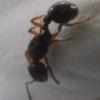Note: please click on images to see full size versions
I've moved my journals here to get some more exposure and to encourage me to keep updating them ![]()
October 2017
I eventually found a species of ants that are European and don't hibernate over winter. Prenolepis Nitens, almost identical to Prenolepis Imparis (American). They have been documented as being active above ground in freezing temperatures. Apparently they hibernate in summer. Perfect.
By some miracle, I found a queen with 3-5 workers for sale online, despite very few people in the UK being familiar with them.
October 27th
My tiny new colony arrived, with 6 workers. Here is a great shot of them in the test tube. The species are known as 'Winter ants' and also as 'False Honey Pot ants', you can see some of the workers (3) have distended gasters, not filled with sweet honey, but actually just fat.
I looked carefully with a magnifying glass, but there did not appear to be any brood. The workers are 2-3mm, so bigger than my L.Niger nanitics. The repletes (I'm going to call them that, but it may not be technically accurate as they are not honey pot ants) walk with a shuffle as they are weighed down at the back, they seem to pause every other step to put their gaster on the ground.
October 29th
The test tube had about a third covered in black mould, so I decided to connect them to a new test tube and shine a bright light on the test tube. They didn't like the light and got quite active under it, but although two workers went in (non-repletes) to explore the new test tube and enjoyed some protein jelly, the colony did not move.
I had a second formicarium+outworld that had been weeks in the post from Ants Russia, which just arrived, so I decided to put some white sand-loam in that and see if the colony would move in there. After a day they began to move!
This was particularly exciting for me as a new ant keeper, because none of my other colonies had ever moved under light. The workers explored the tube, went into the nest and outworld then came back. All of a sudden they all set off queen started to move last. Again no sign of any brood or any workers carrying anything. Then a couple of inches in she turned around and went back with general confusion for the rest of the colony running backward and forward. This happened a coulple of times and then I decided to take the test tube off the end and seal it with cotton wool.
After a couple more hours the queen had ended up at the end of the tube almost in the new nest with one worker and everyone else was back at the other end of the tube sat under the bright light. Eventually after a couple more hours of general confusion with ants seemingly 'lost' in what was quite a long tube and me moving the light to different places only 2 workers were left and the rest were sat at the end about to enter the new nest. After another while of waiting I decided to nudge the last 2 workers down the tube with a pipe cleaner and gently pushed the colony out of the tube and into the entrance of the nest.
It really wasn't my ideal solution as they had looked like they were going to move on their own, but with them stalling at the end of the tube I wasn't sure my pipe cleaner was a solid seal, so I didn't want to leave it in over night in case any escaped. Neither did it quite work to cut the tube in case the small end piece they were all in flew off with the force of the cut (the tubes are quite solid). I guess I found I prefer a natural approach and I appreciate sellers who use a small test tube that will fit in the smaller outworld/nest combinations.
Anyway, as you can see they moved deeper into the nest into the corner of the chamber I'd not filled with white sand.
They really do seem to be sensitive to even red light as this worker got very active when I removed the cover I'd had over them and came as close to my red light as he could get before returning back to the other chamber. I think I'm going to leave them for a week now in peace. They have sand, water, honey and protein jelly, so we'll see what happens. I'm not sure I'll be able to see any eggs that the queen lays as the floor of the nest is white and so is the sand. I've also read that they don't lay many eggs in winter and the brood grown in summer during hibernation. We'll find out.
5th November
I left the colony to settle and be in peace for about a week. I've not see them venture out at all and when looking in on them they seem pretty shy and content in their corner. I'm keeping them at a steady 19*C, so cool, but not cold. I'll drop them down to about 10*C in a couple of weeks when I put the others into hibernation and see if they prefer that.
They seem to be very light sensitive, much more so even than L.Niger, so when light is shone on them (even red) they try and hide away.
No sign that they have left the little corner of the nest or that the Snow queen has laid any eggs. It may be my imagination, but I think the repletes are a little smaller. I've given them honey and sugar water and I'll try them with fruit flies this week. I guess they may wait until they are hungry though until they go out and forage.
12th November
These guys don't seem to have moved much or done anything, they are at 17-18*C now and pretty constant. They haven't found the fruit fly at the nest entrance. They seem just to want to stay at the most humid point right next to the wet sponge in the formicarium. No sign of eggs.
Here's a better shot of the queen:
And one of the workers:
Edited by Dreamer, December 31 2017 - 3:35 PM.




























